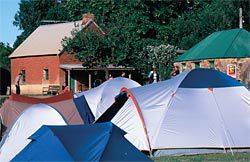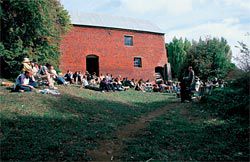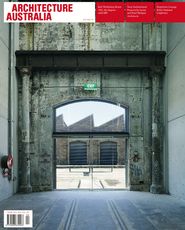
Looking across the tents pitched for the event at the Gala Estate, Cranbrook, on Tasmania’s east coast. Image: Leigh Woolley.

Conversations on the lawn at Cranbrook. Image: Leigh Woolley.
Tasmanian architectural narratives recalled by James Jones.
Architectural narratives are often told around a dinner table or fire, outside the formality of academy or bureau. Some years ago a group of Tasmanian architects decided to hold the Annual Architects Alternative Architectural Awards (AAAAA), mixed with game and local wine. The event, initiated by Bevan Rees, gathered steam and grew to become a triennial event known as the Tasmanian Architectural Narratives. The event is now graciously hosted by the Greenhill family on their pastoral property, the Gala Estate at Cranbrook, and supplied by Bishop’s Rock and Craigie Knowe Vineyards and Banc Restaurant. The Gala Estate is “on” Tasmania’s sublime east coast. Mainlanders are advised to come to terms with the difference between “at” and “on” when talking rural Tasmania, or maybe it’s obvious.
If the redefinition of a building type constitutes research within the discipline of architecture, then Cranbrook redefines what it means to attend a conference, confirmed by Brian Ritchie’s impromptu performance against the mill backdrop (without the Femmes), and by his referential exposé linking Frank Lloyd Wright with Ritchie’s classical Japanese music teachings.
The most spectacular Cranbrook narrative in the past nine years was by Jim Gandy, eminent structural engineer. Gandy presented a precise history of the trebuchet as weapon of mass destruction to the dinner party, followed the next day by a full-scale demonstration, in the paddock adjacent the shearing shed – slinging shot, toilet pan and computer screen over vast distances, to wild applause.
Greg Lehman, at this year’s event, told a spellbinding story of grave robbing on Tasmania’s picturesque east coast, consistent with colonial derogation of human rights and dignity, followed insightfully by Peter Myers’ erudite exposure of J. M. Freeland’s mistake in the book Architecture in Australia: A History.
Peter Myers’ story concerned the Sydney rock oyster industry and the fact that it was successfully operating prior to the First Fleet landing, which redefines “reconciliation” as “recognition” and confronts the so-told facts of British settlement, and the origins of lime. Sydney was not settled by the British “at” Sydney Cove, but “on” people’s oyster beds, “on” people’s country.
Told in the local church with no power, Myers’ analogy between rolling out stripped-back Georgian churches built from sandstone and pattern books across the colonies and at the same time rolling out repetitive farming methods, despite soil type, landform or climate, renders the romantically benign rural and urban landscape that we inherit today unrecognizable.
John Andrews told stories of how he built the idea of the megastructure against incredible odds as an architect in Boston in the 1960s.¹ Andrews is the vanguard to Bob Nation’s recent quest to formally internationalize Australian architecture. While Barry McNeill did not present at Cranbrook in 2007, his unswerving narrative continued by re-identifying and recognizing the quality of John Andrews’ architecture, by inconveniently placing it formally into one of the first-cabs-off-the-rank sustainable narratives built over forty years ago.
Leigh Woolley’s narrative continues to redefine the Australian landscape, from urban typology to landscape geomorphology to global geographic information system, exquisitely representing the southern light through SLR-slide-scan-jpeg – to the point where a digitized positive proves that more is less.
David Travalia described the prospect of architecture and mining tin, linking Chinese spatial history with the cricket bat, indirectly inviting Ricky Ponting to square-cut an important building on Derby next year.
Travalia’s anticipated exploration of the juncture between installation art and architecture recalls the difference between art as a creative freedom and architecture as a creative discipline.² Bevan Rees paid homage to the wunderkammer, which originally described a room rather than a piece of furniture. Two of the most famous seventeenth-century “wonder cabinets” were those of Olaus Wormius (1588–1654) and Athanasius Kircher (1602–1680). These cabinets were fi lled with preserved animals, horns, tusks, skeletons, minerals, artefacts and ephemera and other types of objects. Rees showed a unique collection of Tasmanian wunderkammer, including repositories in some of Hobart’s more obscure colonial drawing rooms.
The Hobart Waterfront International Design Competition was locally represented, combed, argued and critiqued, to the point where it became obvious that the jury’s many-minor-moves mantra requires a cheque-mate move.
On the edge of the Swan River, Sieglinde Karl-Spence’s especially welcome return to Cranbrook was defined by sublime, ephemeral stories on two black vinyl canvasses, each two metres square, laid on the ground.
Meticulously placed found seed and pollen extracts recalled stories linking season, endemic flora and entomology, redefining the museological process as “exhibit-collect”, without “preservation” or “visitation”. Once placed, these urbane flat-light sculptures were swept up and transformed anew, redefining ephemeral art as sketch plan, glowing silently at dawn.
At Cranbrook on the Gala Estate in early autumn, the turf was trodden, the front paddock slashed and the back paddock ploughed. Space is already limited on the riverbank. Bookings are now open. The seeds are broadcast for the next triennial in 2010, or should we go perennial?
James Jones is the incoming president of the RAIA Tasmanian Chapter and practises with Heffernan Button Voss.
¹ Reyner Banham, Megastructure – Urban Futures of the Recent Past, Thames and Hudson, London, 1976, pp. 105, 133–34, 135, 207.
² “Art is a creative freedom – architecture is a creative discipline.” – Petrina Moore, 1994.















